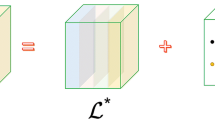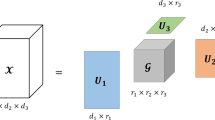Abstract
The T-square operation between two third-order tensors was invented around 2011 and it arises from many applications, such as signal processing, image feature extraction, machine learning, computer vision, and the multi-view clustering problem. Although there are many pioneer works about T-square tensors, there are no works dedicated to inequalities associated with T-square tensors. In this work, we first attempt to build inequalities at the following aspects: (1) trace function nondecreasing/convexity; (2) Golden–Thompson inequality for T-square tensors; (3) Jensen’s T-square inequality; (4) Klein’s T-square inequality. All these inequalities are related to generalize celebrated Lieb’s concavity theorem from matrices to T-square tensors. This new version of Lieb’s concavity theorem under T-square tensor will be used to determine the tail bound for the maximum eigenvalue induced by independent sums of random Hermitian T-square, which is the key tool to derive various new tail bounds for random T-square tensors. Besides, Qi and Zhang (T-quadratic forms and spectral analysis of t-symmetric tensors, 2021) introduces a new concept, named eigentuple, about T-square tensors and they apply this concept to study nonnegative (positive) definite properties of T-square tensors. The final main contribution of this work is to develop the Courant–Fischer Theorem with respect to eigentuples, and this theorem helps us to understand the relationship between the minimum eigentuple and the maximum eigentuple. The main content of this paper is Part I of a serious task about T-square tensors. The Part II of this work will utilize these new inequalities and Courant–Fischer Theorem under T-square tensors to derive tail bounds of the extreme eigenvalue and the maximum eigentuple for sums of random T-square tensors, e.g., T-square tensor Chernoff and T-square tensor Bernstein bounds.
Similar content being viewed by others
Notes
If we scale the random TPD tensor \(\mathcal {X}\) as the \(\lambda _{\max }(e^{t \mathcal {X}}) = 1\), then Eq. (98) is always valid.
References
Ahlswede R, Winter A (2002) Addendum to: “Strong converse for identification via quantum channels” [IEEE Trans. Inform. Theory 48, no. 3, 569–579; MR1889969 (2003d:94069)]. IEEE Trans Inf Theory 49(1), 346. https://doi.org/10.1109/TIT.2002.806161
Braman K (2010) Third-order tensors as linear operators on a space of matrices. Linear Algebra Appl 433(7):1241–1253
Chang SY (2021) Convenient tail bounds for sums of random tensors. arXiv arXiv:2012.15428 math.PR
Chang SY (2021) General tail bounds for random tensors summation: majorization approach. arXiv:2105.06078, math.PR
Chansangiam P (2015) A survey on operator monotonicity, operator convexity, and operator means. Int J Anal Article ID 649839
Csiszár I (1998) The method of types [information theory]. IEEE Trans Inf Theory 44(6):2505–2523
Effros EG (2009) A matrix convexity approach to some celebrated quantum inequalities. Proc Natl Acad Sci USA 106(4):1006–1008. https://doi.org/10.1073/pnas.0807965106
Hiai F (2010) Matrix analysis: matrix monotone functions, matrix means, and majorization. Interdiscip Inf Sci 16(2):139–248
Khalil N, Sarhan A, Alshewimy MA (2021) An efficient color/grayscale image encryption scheme based on hybrid chaotic maps. Opt Laser Technol 143:107326
Kilmer ME, Martin CD (2011) Factorization strategies for third-order tensors. Linear Algebra Appl 435(3):641–658
Kilmer ME, Braman K, Hao N, Hoover RC (2013) Third-order tensors as operators on matrices: A theoretical and computational framework with applications in imaging. SIAM J Matrix Anal Appl 34(1):148–172
Lemm M (2018) On multivariate trace inequalities of sutter, berta, and tomamichel. J Math Phys 59(1):012204. https://doi.org/10.1063/1.5001009
Li X, Wang Y, Huang Z-H (2021) Continuity, differentiability and semismoothness of generalized tensor functions. J Ind Manag Optim 17(6):3525–3550
Martin CD, Shafer R, LaRue B (2013) An order-p tensor factorization with applications in imaging. SIAM J Sci Comput 35(1):A474–A490
Miao Y, Qi L, Wei Y (2020) Generalized tensor function via the tensor singular value decomposition based on the T-product. Linear Algebra Appl 590:258–303
Miao Y, Qi L, Wei Y (2021) T-Jordan canonical form and T-Drazin inverse based on the T-product. Commun Appl Math Comput 3(2):201–220
Qi L, Yu G (2021) T-singular values and t-sketching for third order tensors. arXiv:2103.00976v1
Qi L, Zhang X (2021) T-quadratic forms and spectral analysis of t-symmetric tensors. arXiv preprint. arXiv:2101.10820
Semerci O, Hao N, Kilmer ME, Miller EL (2014) Tensor-based formulation and nuclear norm regularization for multienergy computed tomography. IEEE Trans Image Process 23(4):1678–1693
Settles B, Craven M, Ray S (2007) Multiple-instance active learning. Adv Neural Inf Process Syst 20:1289–1296
Xu Y, Hao R, Yin W, Su Z (2013) Parallel matrix factorization for low-rank tensor completion. Inverse Probl Imaging 9(2):601–624
Zhang Z, Aeron S (2016) Exact tensor completion using t-svd. IEEE Trans Signal Process 65(6):1511–1526
Zhang Z, Ely G, Aeron S, Hao N, Kilmer M (2014) Novel methods for multilinear data completion and de-noising based on tensor-svd. In: Proceedings of the IEEE conference on computer vision and pattern recognition, pp 3842–3849
Zheng M-M, Huang Z-H, Wang Y (2021) T-positive semidefiniteness of third-order symmetric tensors and t-semidefinite programming. Comput Optim Appl 78(1):239–272
Zhou P, Lu C, Lin Z, Zhang C (2017) Tensor factorization for low-rank tensor completion. IEEE Trans Image Process 27(3):1152–1163
Acknowledgements
We would like to thank the handling editor and two reviewers for their detailed comments.
Author information
Authors and Affiliations
Additional information
Communicated by Jinyun Yuan.
Publisher's Note
Springer Nature remains neutral with regard to jurisdictional claims in published maps and institutional affiliations.
Y. Wei is supported by the Innovation Program of Shanghai Municipal Education Commission and the National Natural Science Foundation of China under grant 11771099.
Rights and permissions
About this article
Cite this article
Chang, S.Y., Wei, Y. T-square tensors—Part I: inequalities. Comp. Appl. Math. 41, 62 (2022). https://doi.org/10.1007/s40314-022-01770-0
Received:
Revised:
Accepted:
Published:
DOI: https://doi.org/10.1007/s40314-022-01770-0
Keywords
- Hermitian T-square tensors
- Eigentuples
- Trace function
- Lieb’s concavity for T-square tensors
- Courant–Fischer theorem for T-square tensors




